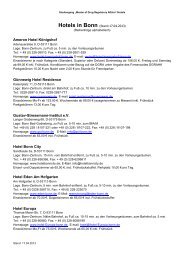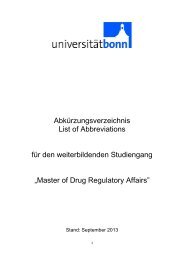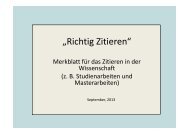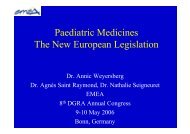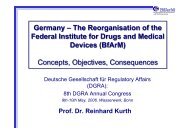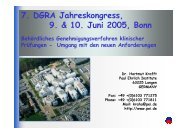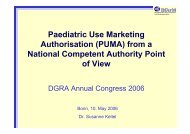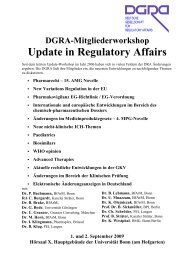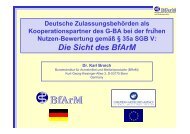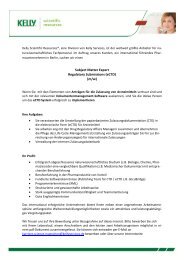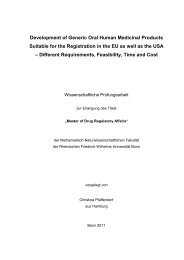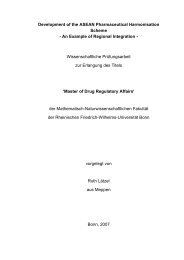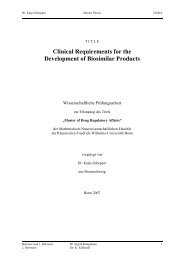Paul-Ehrlich-Institut - DGRA
Paul-Ehrlich-Institut - DGRA
Paul-Ehrlich-Institut - DGRA
You also want an ePaper? Increase the reach of your titles
YUMPU automatically turns print PDFs into web optimized ePapers that Google loves.
• Products and classification<br />
• New procedures and guidelines<br />
• Product-specific considerations<br />
Klaus Cichutek<br />
<strong>Paul</strong>-<strong>Ehrlich</strong>-<strong>Institut</strong>, 63225 Langen, Germany<br />
Chair, EMEA/ CHMP GTWP<br />
E-mail: cickl@pei.de<br />
Bonn, 17 June 2008<br />
Advanced therapy medicinal products<br />
CHMP CHMP GTWP GTWP<br />
<strong>Paul</strong>-<strong>Ehrlich</strong><br />
<strong>Paul</strong> <strong>Ehrlich</strong>-<strong>Institut</strong> <strong>Institut</strong><br />
Federal Agency for Sera and Vaccines
Marketing authorisation of advanced therapy medicinal product<br />
in all EU members states by a single application<br />
for the centralized procedure carried out by EMEA.<br />
Review CHMP CHMP and assessment GTWP GTWP of the MA dossier <strong>Paul</strong>-<strong>Ehrlich</strong><br />
<strong>Paul</strong> by EU <strong>Ehrlich</strong>-<strong>Institut</strong><br />
MS experts, <strong>Institut</strong><br />
e.g., from the <strong>Paul</strong>-<strong>Ehrlich</strong>-<strong>Institut</strong>.<br />
Federal Agency for Sera and Vaccines
A product containing a viable cells is always<br />
a medicinal product, product,<br />
not a medical device<br />
CHMP CHMP GTWP GTWP<br />
(Regulation (EC) No. 1394/2007)<br />
<strong>Paul</strong>-<strong>Ehrlich</strong><br />
<strong>Paul</strong> <strong>Ehrlich</strong>-<strong>Institut</strong> <strong>Institut</strong><br />
Federal Agency for Sera and Vaccines
Gene therapy > cell therapy > tissues engineered MPs<br />
gene therapy products<br />
- cells and nucleic acids<br />
excluding live virus vaccines,<br />
- including live vector and<br />
DNA vaccines<br />
- recombinant nucleic acids in<br />
- viral or non-viral<br />
repl.-incomp. vectors,<br />
- DNA or RNA,<br />
- cells,<br />
CHMP CHMP GTWP GTWP<br />
- rec. replicating viruses/micro-org.<br />
advanced therapy products<br />
immunological SCTs<br />
- DCs, CTLs, NK cells<br />
- engineered cells used for<br />
- adoptive immunotherapy,<br />
- therapeutic vaccination,<br />
- secreting molecules<br />
somatic cell therapy products<br />
tissue engineered<br />
products<br />
- ACT, stem cells<br />
for tissue repair<br />
- engineered cells used<br />
for tissue<br />
- regeneration,<br />
- repair or<br />
- replacement<br />
cell-based cell based <strong>Paul</strong>-<strong>Ehrlich</strong><br />
<strong>Paul</strong> products<br />
<strong>Ehrlich</strong>-<strong>Institut</strong> <strong>Institut</strong><br />
Federal Agency for Sera and Vaccines
Definition of Tissue Engineered Product<br />
in Regulation (EC) No. 1394/2007<br />
CHMP CHMP GTWP GTWP<br />
<strong>Paul</strong>-<strong>Ehrlich</strong><br />
<strong>Paul</strong> <strong>Ehrlich</strong>-<strong>Institut</strong> <strong>Institut</strong><br />
Federal Agency for Sera and Vaccines
Manipulations not considered to result in „engineered“ cells<br />
CHMP CHMP GTWP GTWP<br />
to Regulation (EC) No. 1394/2007<br />
classical<br />
tissue preparations<br />
(national MA)<br />
a few newer<br />
TEPs for cardiovascular<br />
disease<br />
applications,<br />
but nonhomologous<br />
use<br />
(centralized MA via<br />
Federal Agency EMEA) for Sera and Vaccines<br />
<strong>Paul</strong>-<strong>Ehrlich</strong><br />
<strong>Paul</strong> <strong>Ehrlich</strong>-<strong>Institut</strong> <strong>Institut</strong>
Definition of Combined Advanced Therapy Medicinal Product<br />
Definition CHMP CHMP GTWP GTWP of an ATMP for non-homologous<br />
non homologous use<br />
in Regulation (EC) No. 1394/2007<br />
<strong>Paul</strong>-<strong>Ehrlich</strong><br />
<strong>Paul</strong> <strong>Ehrlich</strong>-<strong>Institut</strong> <strong>Institut</strong><br />
Federal Agency for Sera and Vaccines
Final evaluation of combined ATMPs by EMEA and<br />
conformity with requirements for medical devices<br />
CHMP CHMP GTWP GTWP<br />
(Regulation (EC) No. 1394/2007)<br />
<strong>Paul</strong>-<strong>Ehrlich</strong><br />
<strong>Paul</strong> <strong>Ehrlich</strong>-<strong>Institut</strong> <strong>Institut</strong><br />
Federal Agency for Sera and Vaccines
Opinions by stakeholders on the<br />
GTMP definition<br />
• Products to be included<br />
• plasmid DNA (biologically produced nucleic acid)<br />
• non-viral vector<br />
• viral vector<br />
• recombinant and armed oncolytic virus<br />
• recombinant nucleic acid<br />
• genetically modified cell<br />
(cell containing recombinant nucleic acid)<br />
• nucleic acid-containing products used with a view to regulating, repairing or<br />
replacing a targeted genetic sequence<br />
• genetically modified cells where the recombinant nucleic acid is an added,<br />
mutated or deleted genetic sequence<br />
• products whose therapeutic, prophylactic or diagnostic effect relates directly<br />
to the nucleic acid it contains, or to the product of genetic expression of this<br />
nucleic acid<br />
or to cells harbouring a nucleic acid which has these properties<br />
• Products under discussion for inclusion:<br />
• prophylactic vaccines against infectious agents,<br />
• because there are established requirements.<br />
CHMP CHMP GTWP GTWP<br />
<strong>Paul</strong>-<strong>Ehrlich</strong><br />
<strong>Paul</strong> <strong>Ehrlich</strong>-<strong>Institut</strong> <strong>Institut</strong><br />
Federal Agency for Sera and Vaccines
CHMP CHMP GTWP GTWP<br />
Product<br />
fits the definition<br />
of medicinal product<br />
- clinical trial<br />
- compassionate<br />
use (art. 83<br />
of 726/2004)<br />
industrial<br />
production<br />
MA following<br />
risk benefit evaluation<br />
(quality, safety, efficacy, ER)<br />
- 726/2004<br />
- 1394/2007 (ATMP)<br />
MA via<br />
centralized procedure<br />
other<br />
non-industrial<br />
production<br />
MA via<br />
national or<br />
European procedure<br />
- used in or on humans for repairing,<br />
correcting, mod. physiological function<br />
- principal action: pharmacologic,<br />
metabolic or immunologic<br />
- named patient basis (MS)<br />
- without MA necessity in MS<br />
(autologous and directionally<br />
used TEPs)<br />
- hospital exemption (1394/2007)<br />
product/processing authorisation<br />
following evaluation of<br />
safety and functionality<br />
<strong>Paul</strong>-<strong>Ehrlich</strong><br />
<strong>Paul</strong> <strong>Ehrlich</strong>-<strong>Institut</strong> <strong>Institut</strong><br />
Federal Agency for Sera and Vaccines
Klaus Cichutek<br />
<strong>Paul</strong>-<strong>Ehrlich</strong>-<strong>Institut</strong>, 63225 Langen, Germany<br />
Chair, EMEA/ CHMP GTWP<br />
E-mail: cickl@pei.de<br />
Bonn, 17 June 2008<br />
Advanced therapy medicinal products<br />
• Products and classification<br />
• New procedures and guidelines<br />
• Product-specific considerations<br />
CHMP CHMP GTWP GTWP<br />
<strong>Paul</strong>-<strong>Ehrlich</strong><br />
<strong>Paul</strong> <strong>Ehrlich</strong>-<strong>Institut</strong> <strong>Institut</strong><br />
Federal Agency for Sera and Vaccines
Consequences of classification<br />
of a medicinal product as an ATMP<br />
• Classification by EMEA of an MP as ATMP or not (non-binding)<br />
• Marketing authorisation (MA) by the centralized procedure co-ordinated<br />
by EMEA<br />
• For SMEs, fee reductions for EMEA procedures of<br />
• scientific advice and<br />
• marketing authorisation application (MAA)<br />
• Certification procedure for quality and non-clinical data prior to MAA<br />
• Overarching Guidelines by European Commission (EC)<br />
on GCP, GMP and clinical follow-up of patients:<br />
• tracking of donated tissues and cells,<br />
• specific requirements for ATMPs,<br />
• follow-up for safety and efficacy.<br />
• Opinion drafted by CAT and requirements of Part IV, Annex I to<br />
Directive CHMP CHMP 2001/83/EC GTWP GTWP apply.<br />
<strong>Paul</strong>-<strong>Ehrlich</strong><br />
<strong>Paul</strong> <strong>Ehrlich</strong>-<strong>Institut</strong> <strong>Institut</strong><br />
Federal Agency for Sera and Vaccines
Transitional periods<br />
for some Advanced Therapy Medicinal Product<br />
(Regulation (EC) No. 1394/2007)<br />
In some EU member states, autologous and directionally used TEPs<br />
CHMP CHMP GTWP GTWP are currently on the market <strong>Paul</strong>-<strong>Ehrlich</strong><br />
<strong>Paul</strong> <strong>Ehrlich</strong>-<strong>Institut</strong> <strong>Institut</strong><br />
on the basis of a governmental manufacturing authorisation only.<br />
Federal Agency for Sera and Vaccines
Certification of quality and non-clinical<br />
non clinical data<br />
obtained for Advanced Therapy Medicinal Products<br />
CHMP CHMP GTWP GTWP<br />
(Regulation (EC) No. 1394/2007)<br />
<strong>Paul</strong>-<strong>Ehrlich</strong><br />
<strong>Paul</strong> <strong>Ehrlich</strong>-<strong>Institut</strong> <strong>Institut</strong><br />
Federal Agency for Sera and Vaccines
EMEA/CHMP, CAT and Working Parties:<br />
Medicines Agencies in EU MS and EMEA in a network<br />
Biosimilar Products<br />
Working Party<br />
Biologics<br />
Working Party<br />
Vaccine<br />
Working Party<br />
Gene Therapy<br />
Working Party<br />
Blood Products<br />
Working Group<br />
Cell-based Product<br />
Working Party<br />
2x physicians,<br />
2x patient<br />
repr.<br />
CHMP CHMP GTWP GTWP<br />
chair<br />
CHMP<br />
delivers MA<br />
opinion to EC<br />
co-opted members<br />
incldg. PEI co-opted member<br />
chair<br />
27x MS experts<br />
CAT<br />
drafts MA<br />
opinion for<br />
ATMPs<br />
22x MS experts<br />
5x CHMP/CAT double members<br />
incldg. PEI expert<br />
Bio- coordination group<br />
Scientific Advice<br />
Working Party<br />
Pharmacovigilance<br />
Working Party<br />
Safety<br />
Working Party<br />
Quality<br />
Working Party<br />
Efficacy Working<br />
Party<br />
Paediatric Expert<br />
Group<br />
<strong>Paul</strong>-<strong>Ehrlich</strong><br />
<strong>Paul</strong> <strong>Ehrlich</strong>-<strong>Institut</strong> <strong>Institut</strong><br />
Federal Agency for Sera and Vaccines
Klaus Cichutek<br />
<strong>Paul</strong>-<strong>Ehrlich</strong>-<strong>Institut</strong>, 63225 Langen, Germany<br />
Chair, EMEA/ CHMP GTWP<br />
E-mail: cickl@pei.de<br />
Bonn, 17 June 2008<br />
Advanced therapy medicinal products<br />
• Products and classification<br />
• New procedures and guidelines<br />
• Product-specific considerations<br />
CHMP CHMP GTWP GTWP<br />
<strong>Paul</strong>-<strong>Ehrlich</strong><br />
<strong>Paul</strong> <strong>Ehrlich</strong>-<strong>Institut</strong> <strong>Institut</strong><br />
Federal Agency for Sera and Vaccines
A human somatic cell as the active (drug) substance<br />
in a medicinal product<br />
Intracellular molecules<br />
- transcriptome (mRNAs,<br />
siRNAs/shRNAs, etc.<br />
- translated peptides,<br />
proteins<br />
- fatty acids<br />
- activity of protooncogenes<br />
and tumour<br />
suppressor genes<br />
Intracellular state<br />
- signal transduction<br />
pathways<br />
- calcium release<br />
- metabolic functions<br />
- stored active peptides<br />
and proteins<br />
CHMP CHMP GTWP GTWP<br />
Cell behaviour in vivo<br />
- migration<br />
- attraction or repulsion of other cells<br />
- differentiation<br />
- half life in vivo<br />
- natural function in vivo<br />
(structure, immunological, etc.)<br />
Cells in<br />
medicinal<br />
products<br />
Expression of cell surface<br />
molecules related to function<br />
and phenotype<br />
- CDs<br />
- growth factor receptores<br />
- cytokine receptors<br />
- chemolkine receptors<br />
- TCRs<br />
Release of factors<br />
- growth factors<br />
- cytokines<br />
- chemokines<br />
- functional peptides<br />
Genomic state<br />
- cytogenetic abnormalities<br />
- telomers<br />
- activation of proto-oncogenes<br />
- activity<br />
<strong>Paul</strong>-<strong>Ehrlich</strong><br />
<strong>Paul</strong> <strong>Ehrlich</strong>-<strong>Institut</strong> <strong>Institut</strong><br />
Federal Agency for Sera and Vaccines
Hyalo-cartilage<br />
Hyalo cartilage formation in immuno-<br />
suppressed nude mice as a potency<br />
assay for chondrocyte progenitor cells<br />
CHMP CHMP GTWP GTWP<br />
Potency prior to first<br />
clinical use: use:<br />
first<br />
evidence for potential<br />
clinical mechanism of<br />
action and efficacy<br />
Potency assay for<br />
batch release: release<br />
based on genomics<br />
<strong>Paul</strong>-<strong>Ehrlich</strong><br />
<strong>Paul</strong> <strong>Ehrlich</strong>-<strong>Institut</strong> <strong>Institut</strong><br />
Federal Agency for Sera and Vaccines
Human Tissue Engineered Products: examples<br />
Cartilage repair<br />
- Autologous chondrocyte transplantation (ACT)<br />
1st and 2nd generation products<br />
-> only non-inferiority to conv. method demonstrated after 1 year<br />
Skin regeneration<br />
- Acute wounds, diabetic foot skin ulcers<br />
- different skin cells (keratinocytes, fibroblasts)<br />
in combination with a sheet-like matrices/scaffolds<br />
-> ulcer healing may not be predicitive for risk of amputation<br />
Bone regeneration<br />
- Osteoblasts or bone-marrow-derived stem cells combined<br />
with ceramic-based scaffolds or biomaterials<br />
Cardiovascular regeneration<br />
- Hematopoetic stem cells for heart muscle<br />
regeneration<br />
CHMP CHMP GTWP GTWP<br />
<strong>Paul</strong>-<strong>Ehrlich</strong><br />
<strong>Paul</strong> <strong>Ehrlich</strong>-<strong>Institut</strong> <strong>Institut</strong><br />
-> mechanisms underlying cell administration: cells or cytokines?<br />
- Engineered autologous/allogeneic blood vessels or heart valves<br />
Federal Agency for Sera and Vaccines
Cell Therapy Medicinal Products: examples<br />
Liver repair<br />
- Allogenic liver cell suspension for treatment<br />
of acute sepsis<br />
-> reduction of number of fatal outcomes?<br />
or inherited metabolic liver failure<br />
Type I Diabetes<br />
- Allogenic pancreatic islet cell fractions<br />
to restore insulin production<br />
Skin repair<br />
- Various skin cell suspensions for treatment of<br />
acute wounds and diabetic foot skin ulcers<br />
- Autologous adipose-derived stem cells for<br />
treatment of anal fistula<br />
Immunotherapeutics<br />
- CTLs or NK cell transfer for adoptive immuntherapy<br />
Cell-based therapeutic vaccines<br />
- Peptide-loaded DC used as tumor vaccines to<br />
induce immunity CHMP CHMP towards GTWP GTWP tumor-associated antigens<br />
- Fused Tumor/DC hybrid cells<br />
-> efficacy and<br />
<strong>Paul</strong>-<strong>Ehrlich</strong><br />
<strong>Paul</strong><br />
endpoints<br />
<strong>Ehrlich</strong>-<strong>Institut</strong> <strong>Institut</strong><br />
of phase III<br />
efficacy clinical trials<br />
Federal Agency for Sera and Vaccines
CHMP CHMP GTWP<br />
GTWP<br />
<strong>Paul</strong>-<strong>Ehrlich</strong><br />
<strong>Paul</strong> <strong>Ehrlich</strong>-<strong>Institut</strong> <strong>Institut</strong><br />
Federal Agency for Sera and Vaccines
Conditionally replicating oncolytic virus:<br />
ICH Workshop Chicago (November 2005)<br />
Virus engineered to direct their cytotoxicity towards cancer cells<br />
oncolytic<br />
virus<br />
Theoretical advantages:<br />
Theoretical risks:<br />
normal cell: abortive replication<br />
tumor cell<br />
CHMP CHMP GTWP GTWP<br />
productive<br />
replication,<br />
cell lysis<br />
virus kills<br />
tumor cell,<br />
spreads to<br />
neighbours<br />
- viral replication within tumor mass allows infection of additional cells<br />
- lack of cross-resistance with standard therapies<br />
- ability to cause tumor destruction by different mechanisms<br />
<strong>Paul</strong>-<strong>Ehrlich</strong><br />
<strong>Paul</strong> <strong>Ehrlich</strong>-<strong>Institut</strong> <strong>Institut</strong><br />
- introduction of new pathogens into the human population and adaptation<br />
Federal Agency for Sera and Vaccines
Gene therapy<br />
guidelines<br />
(EU, ICH)<br />
CPMP/BWP/3088/99<br />
Note for Guidance on the Quality, Preclinical and<br />
Clinical Aspects of Gene Transfer Medicinal Products<br />
GL Draft<br />
Guideline on<br />
Genetically Modified Cells<br />
CHMP CHMP GTWP GTWP<br />
product-<br />
specific<br />
GL Draft<br />
Guideline on Live Vector and<br />
Recombinant Vaccines<br />
<strong>Paul</strong>-<strong>Ehrlich</strong><br />
<strong>Paul</strong> <strong>Ehrlich</strong>-<strong>Institut</strong> <strong>Institut</strong><br />
Parental EU<br />
gene therapy<br />
guideline<br />
CP Draft<br />
Guideline on DNA Vaccines<br />
Federal Agency for Sera and Vaccines
quality<br />
CPMP/BWP/2458/03<br />
CPMP Position Statement<br />
on Development and<br />
Manufacture of Lentiviral<br />
Vectors<br />
EDQM 5.14.<br />
Gene transfer medicinal<br />
products for human use<br />
EDQM Draft<br />
(Onco) retroviral and<br />
lentiviral vectors for human<br />
use<br />
small-scale GMP<br />
manufacture<br />
non-clinical<br />
studies<br />
CHMP CHMP GTWP GTWP<br />
non-clinical<br />
non clinical<br />
EMEA/CHMP/GTWP/203821/05<br />
Guideline on the Non-Clinical<br />
Studies Prior to Clinical Use of<br />
Gene Therapy Medicinal<br />
Products (Jan 209)<br />
EMEA/273974/05<br />
Guideline on Non-Clinical<br />
Testing for Inadvertent<br />
Germline Transmission of Gene<br />
Transfer Vectors (Nov 2006)<br />
ICH Considerations<br />
General Principles to Address<br />
the Risk of Inadvertant<br />
Germline Integration of Gene<br />
Therapy Vectors (Oct 2006)<br />
pilote<br />
phase I or I/II<br />
non-clinical<br />
non clinical a.<br />
clinical ERA<br />
CHMP/GTWP/125491/06<br />
Guideline on the<br />
Scientific Requirements<br />
for the Environmental<br />
Risk Assessment of<br />
Gene Therapy Medicinal<br />
Products (2008)<br />
phase I/II<br />
large-scale GMP<br />
manufacture<br />
phase II/III<br />
phase III<br />
clinical<br />
GL Draft<br />
Clinical monitoring of<br />
subjects treated with<br />
gene therapy medicinal<br />
products (public<br />
consultation until Nov<br />
2008)<br />
ICH Considerations Draft<br />
Oncolytic Viruse<br />
ICH Considerations Draft<br />
Viral/Vector Shedding<br />
<strong>Paul</strong>-<strong>Ehrlich</strong><br />
<strong>Paul</strong> <strong>Ehrlich</strong>-<strong>Institut</strong> <strong>Institut</strong><br />
CHMP/<br />
CAT<br />
marketing<br />
authorisation<br />
by EC<br />
via EMEA<br />
Federal Agency for Sera and Vaccines
development<br />
genetics/cell definition<br />
Itinerary to ATMP development in the EU:<br />
free scientific advice and MAA review by EMEA<br />
first proof-ofconcept<br />
in<br />
animal<br />
non-clinical<br />
studies<br />
CHMP CHMP GTWP GTWP<br />
national<br />
scientific advice<br />
(e.g., by <strong>Paul</strong>-<br />
<strong>Ehrlich</strong>-<strong>Institut</strong>)<br />
small-scale GMP<br />
manufacture<br />
pilot<br />
phase I or I/II<br />
briefing meeting<br />
(GTWP, CPWP)<br />
phase I/II<br />
EMEA<br />
scientific advvice<br />
(SAWP/CHMP)<br />
large-scale GMP<br />
manufacture<br />
phase II/III<br />
phase III<br />
clinical trial authorization by MS CA<br />
<strong>Paul</strong>-<strong>Ehrlich</strong><br />
<strong>Paul</strong> <strong>Ehrlich</strong>-<strong>Institut</strong> <strong>Institut</strong><br />
CHMP/<br />
CAT<br />
marketing<br />
authorisation<br />
by EC<br />
via EMEA<br />
manufacturing authorization by MS Federal CA Agency for Sera and Vaccines
Safety and efficacy needs to be shown for ATMPs<br />
Regulation (EC) No. 1394/2007:<br />
The same regulatory principles apply as for other<br />
biotechnology MP<br />
• quality, safety and efficacy, ER<br />
• marketing authorisation<br />
• post-authorisation vigilance & RMP<br />
CHMP CHMP GTWP GTWP<br />
<strong>Paul</strong>-<strong>Ehrlich</strong><br />
<strong>Paul</strong> <strong>Ehrlich</strong>-<strong>Institut</strong> <strong>Institut</strong><br />
Federal Agency for Sera and Vaccines
Clinical Development of ATMPs<br />
Guideline on Human Cell-Based Medicinal Products<br />
4.4.1 General aspects<br />
• When a CBMP enters the clinical development phase the same<br />
principles as for other medicinal products apply. ... a deviation<br />
from Phase I to Phase III clinical trials progression is<br />
acceptable but needs to be justified by the specificity of<br />
CBMP.<br />
The clinical development plan should include<br />
• pharmacodynamic studies,<br />
• pharmacokinetic studies,<br />
• mechanism of action studies,<br />
• dose finding studies,<br />
• randomized controlled trials (RCTs)<br />
Frequently asked question:<br />
Is one radomized controlled trial sufficient for an MAA?<br />
CHMP CHMP GTWP GTWP<br />
<strong>Paul</strong>-<strong>Ehrlich</strong><br />
<strong>Paul</strong> <strong>Ehrlich</strong>-<strong>Institut</strong> <strong>Institut</strong><br />
Federal Agency for Sera and Vaccines
Is one randomized controlled trial sufficient?<br />
sufficient<br />
Minimum requirement for one pivotal study (CPMP/EWP/2330/99 Points to<br />
consider on application with 1. Meta-Analysis; 2. one pivotal study)<br />
- statistically compelling and clinically relevant results<br />
Plan for more than 1 study when<br />
- unknown mechanism of action<br />
- new pharmacological principle<br />
- phase I and II data limited<br />
- new therapeutic area with history of failed studies or failures<br />
to confirm convincing results<br />
CHMP CHMP GTWP GTWP<br />
<strong>Paul</strong>-<strong>Ehrlich</strong><br />
<strong>Paul</strong> <strong>Ehrlich</strong>-<strong>Institut</strong> <strong>Institut</strong><br />
Federal Agency for Sera and Vaccines
Safety and clinical efficacy needs to be shown<br />
for ATMPs<br />
• MAA can be applied for for orphan drugs based on a single clinical trial<br />
showing safety and efficacy<br />
• In general a single pivotal phase III trial may suffice to support a MAA,<br />
but<br />
• statistically compelling and clinically relevant results required.<br />
• Primary endpoints usable<br />
• survival time (cancer)<br />
• alternatively: validated surrogate endpoints<br />
Example: Autologous chondrocyte implantation in the knee:<br />
Radiographic evidence by Magnetic Resonance Imaging (MRI) of<br />
cartilage repair may serve as surrogate for clinical outcome (if<br />
validated).<br />
CHMP CHMP GTWP GTWP<br />
<strong>Paul</strong>-<strong>Ehrlich</strong><br />
<strong>Paul</strong> <strong>Ehrlich</strong>-<strong>Institut</strong> <strong>Institut</strong><br />
Federal Agency for Sera and Vaccines
Current revision of Annex I to Dir. 2001/83/EC:<br />
dossier requirements for the MAA<br />
• definitions<br />
• Module 3: quality<br />
• Module 4: nonclinical<br />
• Module 5: clinical<br />
CHMP CHMP GTWP GTWP<br />
changes for GT MPs and SCT MPs,<br />
TEPs defined in AT MP Regulation<br />
GT MPs<br />
SCT MPs incdlg. TEPs<br />
GT MPs<br />
SCT MPs incdlg. TEPs<br />
GT MPs, SCT MPs, TEPs<br />
<strong>Paul</strong>-<strong>Ehrlich</strong><br />
<strong>Paul</strong> <strong>Ehrlich</strong>-<strong>Institut</strong> <strong>Institut</strong><br />
Federal Agency for Sera and Vaccines
sera, sera<br />
Igs, Igs<br />
mAbs<br />
CHMP CHMP GTWP GTWP<br />
vaccines<br />
(human,<br />
vet.) vet.)<br />
allergens<br />
15 min from Frankfurt Int. Airport<br />
<strong>Paul</strong>-<strong>Ehrlich</strong><br />
<strong>Paul</strong> <strong>Ehrlich</strong>-<strong>Institut</strong> <strong>Institut</strong><br />
research topics medicinal product competence<br />
Safety and quality of<br />
biomedicines<br />
Experimental<br />
therapy and<br />
diagnostics<br />
Host interactions<br />
with pathogens and<br />
retroelements<br />
Immune activation<br />
and evasion<br />
gene<br />
therapy<br />
products<br />
pei@pei.de<br />
blood a.<br />
plasma-<br />
derived<br />
products<br />
cell<br />
therapy<br />
products<br />
(human,<br />
xeno) xeno<br />
tissue-<br />
engineered<br />
products<br />
tissue<br />
preparations<br />
advanced<br />
therapy<br />
products<br />
<strong>Paul</strong>-<strong>Ehrlich</strong><br />
<strong>Paul</strong> <strong>Ehrlich</strong>-<strong>Institut</strong> <strong>Institut</strong><br />
BfArM: BfArM<br />
recombinant<br />
proteins,<br />
chemical drugs,<br />
etc.<br />
Federal Agency for Sera and Vaccines
CHMP CHMP GTWP GTWP<br />
Back-up Back up slides<br />
<strong>Paul</strong>-<strong>Ehrlich</strong><br />
<strong>Paul</strong> <strong>Ehrlich</strong>-<strong>Institut</strong> <strong>Institut</strong><br />
Federal Agency for Sera and Vaccines
Module 3 (quality data requirements)<br />
of discussed new Annex I to Dir. 2001/83/EC (1)<br />
• For gene therapy products, the general requirements for medicinal products<br />
apply unless divergence is adequately justified.<br />
• Special attention shall be paid to the following items:<br />
• 3.2.1. Active substance<br />
• 3.2.1.1. Control of Starting materials<br />
• 3.2.1.2. Manufacturing process of the active substance(s)<br />
• 3.2.1.3. Characterisation of the active substance(s)<br />
• 3.2.1.4. Control of the active substance(s)<br />
• 3.2.1.5. Reference standards or materials<br />
• 3.2.1.6. Container and closure system of the active substance(s)<br />
• 3.2.1.7. Stability of the active substance(s)<br />
• 3.2.2. Finished medicinal product<br />
• 3.2.2.1. Description and composition of the finished medicinal product<br />
• 3.2.2.2. Pharmaceutical development<br />
• 3.2.2.3. Manufacturing process of the finished medicinal product<br />
• 3.2.2.4. Control of excipients<br />
• 3.2.2.5. Control of the finished medicinal product<br />
• 3.2.2.6. Reference standards or materials<br />
• 3.2.2.7. Container and closure of the finished medicinal product<br />
• 3.2.2.8. CHMP CHMP Stability GTWP GTWP of the finished medicinal product <strong>Paul</strong>-<strong>Ehrlich</strong><br />
<strong>Paul</strong> <strong>Ehrlich</strong>-<strong>Institut</strong> <strong>Institut</strong><br />
• 3.2.A.2. Adventitious agents safety evaluation<br />
Federal Agency for Sera and Vaccines
Module 4 (nonclinical<br />
( nonclinical data requirements)<br />
of discussed new Annex I to Dir. 2001/83/EC (1)<br />
• RISK ANALYSIS<br />
• The diversity of the group of Advanced Cell Therapy Medicinal Products<br />
means that the pharmaceutical development, non-clinical and clinical<br />
testing and the Risk Management Plans should be proportional/related<br />
to the risk expected from the product.<br />
• A system of risk analysis is applied as an underlying principle which<br />
determines the extent of characterisation in terms of Quality, Nonclinical<br />
and Clinical data to be included in the Marketing Authorisation<br />
application dossier.<br />
• Examples of risk factors are<br />
• the origin of the cells and/or the gene therapy medicinal product,<br />
• ability to proliferate and to differentiate,<br />
• ability to initiate an immune response,<br />
• level of cell manipulation,<br />
• mode of administration,<br />
• combination of cells with bioactive molecules or structural materials,<br />
• chromosomal integration of nucleic acid sequences,<br />
• their longterm functionality or oncogenicity.<br />
• The availability of clinical data or experience with similar ATMP´s can<br />
also be considered.<br />
CHMP CHMP GTWP GTWP<br />
<strong>Paul</strong>-<strong>Ehrlich</strong><br />
<strong>Paul</strong> <strong>Ehrlich</strong>-<strong>Institut</strong> <strong>Institut</strong><br />
Federal Agency for Sera and Vaccines
Module 4 (nonclinical<br />
( nonclinical data requirements; GTMPs) GTMPs<br />
of discussed new Annex I to Dir. 2001/83/EC (2)<br />
• Specific GTMP aspects<br />
• The appropriate level of nonclinical safety evaluation should be provided.<br />
• Viral vectors and genetically modified replicating micro-organisms and<br />
viruses<br />
• The rationale underlying the design of viral vectors - the use of<br />
replication-incompetent viral vectors or replicating micro-organisms and<br />
viruses- should be provided.<br />
• Genetically modified cells<br />
• The rationale underlying the use of the specific cell type, the use of the<br />
nucleic acid sequence introduced for their genetic modification and the<br />
result of the genetic modification should be provided.<br />
• Functional nucleic acid sequences<br />
• The rationale underlying the design of the nucleic acid sequence, and its<br />
functionality should be provided.<br />
CHMP CHMP GTWP GTWP<br />
<strong>Paul</strong>-<strong>Ehrlich</strong><br />
<strong>Paul</strong> <strong>Ehrlich</strong>-<strong>Institut</strong> <strong>Institut</strong><br />
Federal Agency for Sera and Vaccines
Module 4 (nonclinical<br />
( nonclinical data requirements; GTMPs) GTMPs<br />
of discussed new Annex I to Dir. 2001/83/EC (4)<br />
• Toxicology<br />
• Toxicity of the gene therapy medicinal product shall be assessed, not<br />
only for the drug substance.<br />
• Individual testing of drug components and excipients shall be taken into<br />
consideration, where appropriate.<br />
• The in vivo effect of expression of nucleic acid sequence-related<br />
products not intended for the physiological function shall be evaluated.<br />
• Single-dose toxicity: A single dose toxicity study should be conducted<br />
using the clinical route of administration and mode of application.<br />
• Repeated dose toxicity: Studies shall be provided when multiple dosing<br />
of human subjects is intended. For those cases where single dosing may<br />
result in prolonged nucleic acid sequence functionality in humans<br />
repeated toxicity studies shall be considered. The application mode and<br />
scheme should closely reflect the planned clinical application. The<br />
duration of observations may be longer than in standard toxicity studies<br />
depending on the persistence of the gene therapy product.<br />
• Genotoxicity: Standard genotoxicity studies are not generally required.<br />
However, genotoxicity studies may be required to address a concern<br />
about a specific impurity or a component of the delivery system.<br />
• Carcinogenicity/ oncogenicity/ tumorigenicity studies: Standard life-time<br />
rodent carcinogenicity studies are not generally required. However, if an<br />
oncogenic potential of the gene therapy medicinal product may be<br />
assumed it should be evaluated in appropriate in vivo/in vitro models.<br />
CHMP CHMP GTWP GTWP<br />
<strong>Paul</strong>-<strong>Ehrlich</strong><br />
<strong>Paul</strong> <strong>Ehrlich</strong>-<strong>Institut</strong> <strong>Institut</strong><br />
Federal Agency for Sera and Vaccines
Module 4 (nonclinical<br />
( nonclinical data requirements; GTMPs) GTMPs<br />
of discussed new Annex I to Dir. 2001/83/EC (5)<br />
• Reproductive and developmental toxicity: Non-clinical germline<br />
transmission studies shall be provided, as appropriate.<br />
• Studies on the effects on fertility and general reproductive function shall<br />
be provided. Embryo-foetal and perinatal toxicity studies shall be<br />
provided, if women of child-bearing potential or children are exposed to<br />
gene therapy product, unless the absence of such studies is justified.<br />
• Integration studies: Integration studies shall be provided for any gene<br />
therapy medicinal product, unless the lack of these studies is<br />
scientifically justified, e.g. because nucleic acid sequences will not enter<br />
into the cell nucleus. For gene therapy medicinal products not expected<br />
to be capable of integration, integration studies shall be performed, if<br />
biodistribution data indicate a risk for germ line transmission. Nucleic<br />
acid sequence copy number per cell or tissue shall be taken into account<br />
for studies supporting dose definition.<br />
• Immunogenicity and immunotoxicity: It is expected that immunological<br />
responses occur when an allogeneic or xenogeneic product is<br />
introduced. To address immunogenicity or immunotoxicity issues, the<br />
use of homologous models mimicking the clinical approach is<br />
recommended.<br />
• Immunogenicity and immunotoxicity studies shall be provided for those<br />
gene therapy medicinal products that carry specific functions known to<br />
have an effect on the immune system. When an immunological response<br />
is intended against the gene therapy or nucleic acid sequence product,<br />
immunogenicity and immunotoxicity shall be investigated appropriately.<br />
CHMP CHMP GTWP GTWP<br />
• Unexpected and undesirable consequences <strong>Paul</strong>-<strong>Ehrlich</strong><br />
<strong>Paul</strong> of long-term <strong>Ehrlich</strong>-<strong>Institut</strong> expression <strong>Institut</strong> of a<br />
foreign antigen should be evaluated, as appropriate.<br />
Federal Agency for Sera and Vaccines
Module 5 (clinical data requirements)<br />
of discussed new Annex I to Dir. 2001/83/EC (3)<br />
• For the deliberate release in the environment, attention shall be paid to the<br />
persistence of the Genetically Modified Organisms in the recipient and to the<br />
possible replication and/or modification of the Genetically Modified Organism<br />
when released in the environment.<br />
• Human Pharmacokinetic (PK) studies shall include the following aspects:<br />
• Shedding studies to address the excretion of the gene therapy medicinal<br />
product .<br />
• Biodistribution of the vector, including distribution to gonads,.<br />
• The pharmacokinetics of the transgene.<br />
• Human Pharmacodynamic studies should address<br />
• the correlation between vector distribution,<br />
• the expression of the transgene and the therapeutic response.<br />
• The adequate dose to be used for efficacy studies should be defined on<br />
the basis of relevant functional and, as appropriate, structural<br />
parameters.<br />
• Safety studies shall address the following aspects:<br />
• Emergence of replication competent vector<br />
• Potential for recombination or re-assortment<br />
• Release of endogenous virus in case of genetically modified cells<br />
• Risk of persistence of viral vector or latency<br />
• Risk of genomic integration and neoplastic proliferation due to insertional<br />
mutagenicity CHMP CHMP GTWP GTWP<br />
<strong>Paul</strong>-<strong>Ehrlich</strong><br />
<strong>Paul</strong> <strong>Ehrlich</strong>-<strong>Institut</strong> <strong>Institut</strong><br />
• immune response against all components of the gene therapy product<br />
Federal Agency for Sera and Vaccines
Module 5 (clinical data requirements)<br />
of discussed new Annex I to Dir. 2001/83/EC (4-1) (4 1)<br />
• For somatic CTMP whose primary mode of action is based on the<br />
production of active biomolecules, the study of the pharmacokinetic<br />
profile (in particular distribution, duration and amount of expression) of<br />
these molecules may be required.<br />
• The biodistribution, persistence and long term engraftment of the CTMP<br />
components should be addressed during the clinical development.<br />
• Safety studies shall address the following aspects were required:<br />
• distribution and engrafting following administration<br />
• ectopic engraftment<br />
• oncogenic transformation and cell/tissue lineage fidelity<br />
• Pharmacokinetics<br />
• Conventional pharmacokinetics may not be relevant. However the<br />
biodistribution, persistence and long-term engraftment or<br />
degradation of the product should be evaluated early during clinical<br />
development. For somatic CTMP whose primary mode of action is<br />
based on the production of active biomolecules, the assessment of<br />
the pharmacokinetic profile (in particular distribution, duration and<br />
amount of expression) of these molecules may be required.<br />
CHMP CHMP GTWP GTWP<br />
<strong>Paul</strong>-<strong>Ehrlich</strong><br />
<strong>Paul</strong> <strong>Ehrlich</strong>-<strong>Institut</strong> <strong>Institut</strong><br />
Federal Agency for Sera and Vaccines
New legislation and regulations on<br />
advanced therapy medicinal products<br />
• Regulation (EC) No. 1394/2007 on<br />
advanced therapy medicinal products<br />
• Revision of Annex I to Directive<br />
2001/83/EC<br />
• CAT and guidelines developed by<br />
CHMP Working Parties on<br />
cell-based products and<br />
gene therapy<br />
Klaus Cichutek<br />
<strong>Paul</strong>-<strong>Ehrlich</strong>-<strong>Institut</strong>, 63225 Langen, Germany<br />
Chair, EMEA/ CHMP GTWP<br />
E-mail: cickl@pei.de<br />
Washington DC, 29 January 2008<br />
CHMP CHMP GTWP GTWP<br />
<strong>Paul</strong>-<strong>Ehrlich</strong><br />
<strong>Paul</strong> <strong>Ehrlich</strong>-<strong>Institut</strong> <strong>Institut</strong><br />
Federal Agency for Sera and Vaccines
1<br />
2<br />
3<br />
The legal framework for tissues and cells has been provided<br />
1 + 2<br />
Legilsation addressing all<br />
Advanced Therapy Medicinal Products<br />
Legislation on Tissues & Cells,<br />
addressing<br />
all cell-containing products<br />
Technical Requirements<br />
for tissues and cells<br />
Guidelines<br />
CHMP CHMP GTWP GTWP<br />
Regulation on Advanced Therapy Medicinal Products (ATPs)<br />
Definition of ATPs including TE products<br />
-> central licensing required<br />
Directive 2001/83/EC (Nov 2001) amendend by 2003/63/EC (Jun 2003)<br />
Community code relating to all medicinal products for human use<br />
Technical requirements with a view to licensing<br />
Directive 2006/17/EC<br />
technical requirements for<br />
donation, procurement and testing<br />
Regulation 726/2004 (Mar 2004)<br />
Centralized procedure via EMEA<br />
Directive 2004/23/EC (Mar 2004)<br />
setting standards of quality and safety for donation, procurement, testing,<br />
processing, preservation, storage and distribution of human tissues/cells<br />
Directive 2006/86/EC<br />
technical requirements for<br />
coding, processing, preservation,<br />
storage, distribution<br />
Guideline on cell-based products including TEPs<br />
(2008 until present)<br />
Note for guidance on…gene transfer medicinal products<br />
and <strong>Paul</strong>-<strong>Ehrlich</strong><br />
<strong>Paul</strong> related<strong>Ehrlich</strong>-<strong>Institut</strong> guidance <strong>Institut</strong><br />
(2003 until present)<br />
Federal Agency for Sera and Vaccines
The centralized MA allows SMEs with small and<br />
individual products to enter the pan-EU pan EU market<br />
• rapp. assessment<br />
by appointed experts<br />
• CHMP clearance<br />
<strong>Paul</strong>-<strong>Ehrlich</strong><br />
<strong>Paul</strong> <strong>Ehrlich</strong>-<strong>Institut</strong> <strong>Institut</strong><br />
• marketing authorisation by the EC<br />
CHMP CHMP GTWP GTWP<br />
• single application (dossier)<br />
• formal acceptance by EMEA<br />
• (co)-rapporteurs nominated by CAT<br />
• co-rapp. assessment<br />
by appointed experts<br />
• CAT proposal for a decision<br />
• assessment<br />
by other CAT members<br />
Federal Agency for Sera and Vaccines
Gendux gibt bekannt, dass der Marktzulassungsantrag für sein Medikament ADVEXIN von<br />
der EMEA zur Überprüfung angenommen wurde<br />
DUBLIN--(BUSINESS WIRE)--Gendux Molecular Limited („Gendux”) gab heute bekannt, dass sein<br />
Marktzulassungsantrag (Marketing Authorization Application = „MAA”) für ADVEXIN® („Contusugene<br />
Ladenovec”) von der Europäischen Arzneimittelagentur („EMEA”) zur fachlichen Überprüfung<br />
angenommen wurde. ADVEXIN® dient zur Behandlung einer Form des hereditären Krebses, dem Li-<br />
Fraumeni Syndrom („LFS”). Wie Gendux verkündete, war dessen MAA für ADVEXIN am 13. November<br />
2007 bei der EMEA eingereicht worden. ADVEXIN ist die erste Therapie, die speziell auf ein vererbbares<br />
Krebbsyndrom ausgerichtet ist. Die Wirkung von ADVEXIN besteht in der Umkehrung eines der<br />
häufigsten genetischen Krebsdefekte, Anomalien der p53 Tumorsuppressor-Werte, die bei Li-Fraumeni-<br />
Patienten vererbt sind und in der Mehrzahl der nicht-vererbbaren Krebserkrankungen vorkommen.<br />
ADVEXIN wird darüberhinaus als Therapie für Kopf- und Nackenkrebs entwickelt; die Eingaben für diese<br />
Indikation werden sowohl in Europa als auch in den USA vor Ende des Jahres 2007 erwartet.<br />
Die Genehmigung des MAA für ADVEXIN wird die behördliche Überprüfung der präklinischen und<br />
klinischen Daten, sowie der Herstellungsdaten des Antrags durch die EMEA einleiten.<br />
CHMP CHMP GTWP GTWP<br />
<strong>Paul</strong>-<strong>Ehrlich</strong><br />
<strong>Paul</strong> <strong>Ehrlich</strong>-<strong>Institut</strong> <strong>Institut</strong><br />
Federal Agency for Sera and Vaccines
New legislation and regulations on<br />
advanced therapy medicinal products<br />
• Regulation (EC) No. 1394/2007 on<br />
advanced therapy medicinal products<br />
• Revision of Annex I to Directive<br />
2001/83/EC<br />
• CAT and guidelines developed by<br />
CHMP Working Parties on<br />
cell-based products and<br />
gene therapy<br />
Klaus Cichutek<br />
<strong>Paul</strong>-<strong>Ehrlich</strong>-<strong>Institut</strong>, 63225 Langen, Germany<br />
Chair, EMEA/ CHMP GTWP<br />
E-mail: cickl@pei.de<br />
Washington DC, 29 January 2008<br />
CHMP CHMP GTWP GTWP<br />
<strong>Paul</strong>-<strong>Ehrlich</strong><br />
<strong>Paul</strong> <strong>Ehrlich</strong>-<strong>Institut</strong> <strong>Institut</strong><br />
Federal Agency for Sera and Vaccines
Industrially produced tissues and cells<br />
which are engineered/genetically<br />
engineered genetically modified<br />
or used non-homologously<br />
non homologously<br />
are advanced therapy products and<br />
have to obtain marketing authorisation via EMEA<br />
cell-containing<br />
blood product<br />
(as regulated by<br />
Dir. 2002/98/EC)<br />
genetically<br />
modified<br />
human cell-containing<br />
gene therapy<br />
medicinal product<br />
engineered<br />
(as defined in annex I<br />
to Dir. 1394/2007/EC)<br />
or<br />
non-homologous use<br />
human somatic<br />
cell therapy or<br />
tissue engineered<br />
medicinal product<br />
manufacturing authorisation<br />
and EU-wide<br />
marketing authorisation<br />
via the centralized procedure<br />
CHMP CHMP GTWP GTWP<br />
use in haematopoietic<br />
reconstitution or<br />
transfusion medicine<br />
starting material of<br />
product is human<br />
tissue or cells<br />
(viable, irradiated,<br />
cell shape intact)<br />
manufacture:<br />
at least one viable cell is retained,<br />
therefore metabolic action<br />
and medicinal product<br />
industrial manufacture non-industrial manufacture<br />
or hospital exemption<br />
not engineered<br />
or<br />
homologous use<br />
human cell-containing<br />
medicinal product<br />
donation regulated<br />
by Dir. 2004/23/EC<br />
cell-containing<br />
medicinal product<br />
national<br />
manufacturing authorisation<br />
authorisation<br />
and national <strong>Paul</strong>-<strong>Ehrlich</strong><br />
<strong>Paul</strong> <strong>Ehrlich</strong>-<strong>Institut</strong> <strong>Institut</strong> or certification<br />
marketing authorisation<br />
Federal Agency (as for spec. Sera in and 2004/23/EC) Vaccines
Reiterative phase I trials mark the beginning of<br />
ATMP development and informal briefing meetings are needed<br />
development<br />
genetics<br />
first proof-ofconcept<br />
in<br />
animal<br />
non-clinical<br />
studies<br />
CHMP CHMP GTWP GTWP<br />
national<br />
scientific advice<br />
(e.g., by <strong>Paul</strong>-<br />
<strong>Ehrlich</strong>-<strong>Institut</strong>)<br />
small-scale GMP<br />
manufacture<br />
orientational<br />
phase I or I/II<br />
briefing meeting<br />
(GTWP, CPWP)<br />
phase I/II<br />
EMEA<br />
scientific advvice<br />
(SAWP/CHMP)<br />
large-scale GMP<br />
manufacture<br />
phase II/III<br />
phase III<br />
clinical trial authorization by MS CA<br />
<strong>Paul</strong>-<strong>Ehrlich</strong><br />
<strong>Paul</strong> <strong>Ehrlich</strong>-<strong>Institut</strong> <strong>Institut</strong><br />
CHMP/<br />
CAT<br />
marketing<br />
authorisation<br />
by EC<br />
via EMEA<br />
manufacturing authorization by MS Federal CA Agency for Sera and Vaccines
How will we scope with individually prepared<br />
products for very few patients?<br />
• Will a small phase I/II study be acceptable for MA?<br />
• Can we classify the small-scale individual production as industrial<br />
manufacture?<br />
• Do GMP and GCP requirements need special adaptation to smallscale<br />
ATMP production?<br />
CHMP CHMP GTWP GTWP<br />
<strong>Paul</strong>-<strong>Ehrlich</strong><br />
<strong>Paul</strong> <strong>Ehrlich</strong>-<strong>Institut</strong> <strong>Institut</strong><br />
Federal Agency for Sera and Vaccines
Reasons for regulatory classification are the resulting<br />
regulatory and procedural consequences<br />
• Advanced therapy medicinal products (AT-MPs) contain or consist of<br />
• intendedly manipulated cells resulting in substantial alteration of their<br />
biological characteristics (hSCT-MPs)<br />
• “engineered” cells (TEPs)<br />
• vectors (viral, non-viral, naked DNA), replicating (oncolytic) viruses,<br />
vector-containing cells (gene therapy MPs)<br />
• Xenogeneic cells (xenogeneic cell therapy MPs).<br />
• As a consequence of being classified as SCT-MPs, it is necessary<br />
• to obtain marketing authorisation for use in standard therapy<br />
• via the centralised procedure (coordinated by CAT/CHMP at EMEA),<br />
• which is a marketing authorisation for all EU member states via a single<br />
application to the European Medicines Agency (EMEA),<br />
• to undertake clinical trials under GCP intended to collect data for<br />
marketing authorisation have to be done (authorisation within 90 days),<br />
• to obtain manufacturing authorisation including GMP,<br />
• to undertake some non-clinical pharmacological-toxicological studies<br />
under GLP.<br />
CHMP CHMP GTWP GTWP<br />
<strong>Paul</strong>-<strong>Ehrlich</strong><br />
<strong>Paul</strong> <strong>Ehrlich</strong>-<strong>Institut</strong> <strong>Institut</strong><br />
Federal Agency for Sera and Vaccines
Avanced Therapy Clinical Trial Applications<br />
in the EU since August 2004 (20.08.2007, EudraCT) EudraCT<br />
clinical use number<br />
Gene therapy/transfer MPs 67 trials / 33 original products<br />
cancer 19<br />
cardio-vascular 4<br />
autoimmune diseases 2<br />
HIV vaccine 2<br />
infectious disease (chronic hepatitis C) 1<br />
neuronal 2<br />
vaccines (monovalent, combi-) 3<br />
CHMP CHMP GTWP GTWP<br />
Biologicals (EU) <strong>Paul</strong>-<strong>Ehrlich</strong><br />
<strong>Paul</strong> <strong>Ehrlich</strong>-<strong>Institut</strong> <strong>Institut</strong> 5977<br />
Federal Agency for Sera and Vaccines
Avanced Therapy Clinical Trial Applications<br />
in the EU since August 2004 (20.08.2007, EudraCT) EudraCT<br />
clinical use number<br />
Somatic cell therapy MPs 120 trials / 101 original products<br />
cancer immunotherapy 39<br />
cardio-vascular 29<br />
skin/liver/lung/eye/diabetes/intestine/bone TE 25<br />
neurological 5<br />
lymphohistiocytosis (HLH) 1<br />
AIDS 1<br />
infertility 1<br />
CHMP CHMP GTWP GTWP<br />
Biologicals (EU) <strong>Paul</strong>-<strong>Ehrlich</strong><br />
<strong>Paul</strong> <strong>Ehrlich</strong>-<strong>Institut</strong> <strong>Institut</strong> 5977<br />
Federal Agency for Sera and Vaccines
Advanced Therapy Medicinal Products:<br />
Present and Future Regulation in the EU<br />
• Advanced Therapy<br />
Medicinal Products<br />
• Are we prepared?<br />
• What will be the productrelated<br />
issues?<br />
Klaus Cichutek<br />
<strong>Paul</strong>-<strong>Ehrlich</strong>-<strong>Institut</strong>, 63225 Langen, Germany<br />
Chair, CHMP/EMEA GTWP<br />
E-mail: cickl@pei.de<br />
Viseu, 20 November 2007<br />
CHMP CHMP GTWP GTWP<br />
<strong>Paul</strong>-<strong>Ehrlich</strong><br />
<strong>Paul</strong> <strong>Ehrlich</strong>-<strong>Institut</strong> <strong>Institut</strong><br />
Federal Agency for Sera and Vaccines
Aims of non-clinical<br />
non clinical studies prior to first clinical use: use<br />
preventive vaccine<br />
• Studies should be designed and carried out aiming at establishing the<br />
following:<br />
• functionality and proof-of-concept in non-clinical model(s)<br />
• release of biologically active molecules<br />
• maintenance of the intended phenotype and absence of pre-neoplastic<br />
changes<br />
• biodistribution and half-life in the living organism<br />
• recommendation on initial dose and dose escalation scheme to be used<br />
in the proposed clinical trial (max. feasible dose)<br />
• identification of potential mechanisms and target organs of toxicity<br />
• identification of parameters to be monitored in the proposed clinical trial<br />
• identification of patient eligibility criteria<br />
CHMP CHMP GTWP GTWP<br />
<strong>Paul</strong>-<strong>Ehrlich</strong><br />
<strong>Paul</strong> <strong>Ehrlich</strong>-<strong>Institut</strong> <strong>Institut</strong><br />
Federal Agency for Sera and Vaccines
Changes accrdg. accrdg.<br />
to the EC ATMP Proposal<br />
• Centralized licensing procedure for all ATMPs<br />
• Gene therapy products<br />
• Human somatic cell therapy products<br />
• Xenogeneic somatic cell therapy products<br />
• Tissue engineered products<br />
• Autologous and directionally used medicinal products<br />
will undergo licensing<br />
• cell banks<br />
• industrially produced<br />
• Tissue engineered products and somatic cell therapy<br />
products will undergo central licensing,<br />
• live (viable) and<br />
• substantially altered or engineered ????<br />
CHMP CHMP GTWP GTWP<br />
<strong>Paul</strong>-<strong>Ehrlich</strong><br />
<strong>Paul</strong> <strong>Ehrlich</strong>-<strong>Institut</strong> <strong>Institut</strong><br />
Federal Agency for Sera and Vaccines
Short list of pre-requisites pre requisites for a first clinical trial (1)<br />
• Established manufacturing method<br />
• Validated manufacturing process according to GMP<br />
• Setting of rational and state-of-the-art product acceptance criteria<br />
• for the active substance and<br />
• for contaminants (from cell substrate or from culture media)<br />
• proteins<br />
• DNA<br />
• specific cell genes (e.g., oncogenes) or gene products from cell<br />
substrate<br />
• Evidence for intended mechanism in animals<br />
• Single (and repeated) dose toxicity tested (GLP)<br />
• organ toxicity/biodistribution/half-life<br />
• auto-immune disease<br />
• Local tolerance if applicable<br />
CHMP CHMP GTWP GTWP<br />
<strong>Paul</strong>-<strong>Ehrlich</strong><br />
<strong>Paul</strong> <strong>Ehrlich</strong>-<strong>Institut</strong> <strong>Institut</strong><br />
Federal Agency for Sera and Vaccines
Short list of pre-requisites pre requisites for a first clinical trial (2)<br />
• Established first dose<br />
• Established maximum tolerated or maximum feasible dose<br />
• Dosing regimen<br />
• Clinical trial design, statistics<br />
• Inclusion/exclusion criteria<br />
• Medical interventions<br />
• Tests and medical interventions planned during the clinical trial<br />
• Patients´ follow-up, if applicable<br />
• Investigator´s brochure<br />
• Patient information leaflet<br />
CHMP CHMP GTWP GTWP<br />
<strong>Paul</strong>-<strong>Ehrlich</strong><br />
<strong>Paul</strong> <strong>Ehrlich</strong>-<strong>Institut</strong> <strong>Institut</strong><br />
Federal Agency for Sera and Vaccines
Licensing,<br />
scientific advice<br />
Dev. of NfGs (EMEA)<br />
CHMP Gene Therapy WP<br />
(EMEA/CHMP)<br />
WHO Clinical Gene Therapy<br />
Monitoring Group<br />
Innovative biotechnology medicinal products<br />
Gene Transfer Medicinal Products (vectors, DNA, gen. mod. cells, micro-org.)<br />
Somatic/Xenogeneic Cell Therapy MPs (human cells; immunotherapy)<br />
Tissue Engineering MPs (human cells incldg. stem cells)<br />
Tissue Preparations (human sinews, valves, bones,…)<br />
CHMP CHMP GTWP GTWP<br />
<strong>Paul</strong>-<strong>Ehrlich</strong><br />
<strong>Paul</strong> <strong>Ehrlich</strong>-<br />
<strong>Institut</strong><br />
Medical Biotechnology<br />
Basic scientific research<br />
Retrovirology ( HIV / SIV and HERV / PERV )<br />
Gene therapy ( AIDS and tumor gene therapy )<br />
Clinical trial,<br />
manufacture<br />
Commission of<br />
Somatic Gene Therapy<br />
Clinical trial approval<br />
Inspections<br />
<strong>Paul</strong>-<strong>Ehrlich</strong><br />
<strong>Paul</strong> <strong>Ehrlich</strong>-<strong>Institut</strong> <strong>Institut</strong><br />
Cell therapy/TE ( Signal transduction, stem cell diff. )<br />
Federal Agency for Sera and Vaccines
Cell-based Cell based product guideline:<br />
General credo of non-clinical non clinical development<br />
• Objectives of non-clinical studies<br />
• demonstrate proof-of-principle<br />
• define pharmacological and toxicological effects to be expected during<br />
human use<br />
• select a safe dose for human use<br />
• support route of administration and application schedule<br />
• measure duration of exposure (half-life of cells and their effect in vivo)<br />
• define reasonable follow-up time to detect adverse reactions<br />
• detect target organs of toxicity and parameters for patient monitoring in<br />
subsequent clinical trials<br />
• Use relevant animal models and justify:<br />
• Expression level of biologically active molecules,<br />
• route of administration,<br />
• dosage…<br />
• …should reflect the intended human use.<br />
• Consider ICH S6 Guideline on the safety of biotechnology-derived<br />
pharmaceuticals<br />
• Demonstrate safety and suitability of all components for all intended functions.<br />
CHMP CHMP GTWP GTWP<br />
<strong>Paul</strong>-<strong>Ehrlich</strong><br />
<strong>Paul</strong> <strong>Ehrlich</strong>-<strong>Institut</strong> <strong>Institut</strong><br />
Federal Agency for Sera and Vaccines
• Use reasonably justified markers of pharmacodynamic action in vivo<br />
• Cells used to substitute for functions of deficient cells or tissues<br />
-> Measure these cell functions and body function restoration in vivo and in<br />
vitro.<br />
• Cells used for adoptive immunotherapy or vaccination in cancer patients<br />
-> Use immune assays capturing the intended immunological effect.<br />
• Homologous animal model use<br />
• may be advantageous to mimick the human situation more closely,<br />
• should be considered to study stem cell differentiation.<br />
• Use in vitro studies to address<br />
• cell and tissue morphology,<br />
• proliferation,<br />
• phenotype,<br />
Cell-based Cell based product guideline:<br />
primary pharmacodynamics of cells (1)<br />
• heterogeneity and<br />
CHMP CHMP GTWP GTWP<br />
• the level of differentiation.<br />
<strong>Paul</strong>-<strong>Ehrlich</strong><br />
<strong>Paul</strong> <strong>Ehrlich</strong>-<strong>Institut</strong> <strong>Institut</strong><br />
Federal Agency for Sera and Vaccines
Cell-based Cell based product guideline:<br />
primary pharmacodynamics of cells (2)<br />
• Determine minimal or optimal cell amount to be administered<br />
for achieving the desired effect:<br />
• cell number,<br />
• cell concentration,<br />
• required cell characteristics<br />
• stage of differentiation,<br />
• heterogeneity required or tolerated).<br />
CHMP CHMP GTWP GTWP<br />
<strong>Paul</strong>-<strong>Ehrlich</strong><br />
<strong>Paul</strong> <strong>Ehrlich</strong>-<strong>Institut</strong> <strong>Institut</strong><br />
Federal Agency for Sera and Vaccines
Cell-based Cell based product guideline:<br />
secondary and safety pharmacodynamics of cells (2)<br />
• Secondary pharmacodynamics:<br />
Investigate potential undesired effects of the cell-based product:<br />
• homing to other than the intended organs,<br />
• secretion of other bioactive molecules beside the protein(s) of interest,<br />
• undesirable effects of the protein(s) of interest,<br />
• undesirable targets of the protein(s) of interest.<br />
• Safety pharmacodynamics:<br />
Due to secretion of pharmacologically active substances from cells, there may<br />
be<br />
• CNS dysfunctions,<br />
• cardiac dysfunctions,<br />
• respiratory dysfunctions,<br />
• renal dysfunctions<br />
• gastrointestinal dysfunctions.<br />
• Watch ICH S7A Note for guidance on safety pharmacology studies for human<br />
pharmaceuticals (CPMP/ICH/539/00), when applicable.<br />
CHMP CHMP GTWP GTWP<br />
<strong>Paul</strong>-<strong>Ehrlich</strong><br />
<strong>Paul</strong> <strong>Ehrlich</strong>-<strong>Institut</strong> <strong>Institut</strong><br />
Federal Agency for Sera and Vaccines
Cell-based Cell based product guideline:<br />
kinetics, migration persistance of cells (3)<br />
• Conventional ADME studies are genrally not relevant.<br />
• Relevant are measurements of<br />
• tissue distribution,<br />
• viability,<br />
• trafficking,<br />
• growth,<br />
• phenotype and<br />
• any alteration of phenotype due to factors in the new environment.<br />
CHMP CHMP GTWP GTWP<br />
<strong>Paul</strong>-<strong>Ehrlich</strong><br />
<strong>Paul</strong> <strong>Ehrlich</strong>-<strong>Institut</strong> <strong>Institut</strong><br />
Federal Agency for Sera and Vaccines
Cell-based Cell based product guideline:<br />
kinetics, migration persistance of cells (4)<br />
• Conventional ADME studies are generally not relevant.<br />
• Relevant are measurements of<br />
• tissue distribution,<br />
• viability,<br />
• trafficking,<br />
• growth,<br />
• phenotype and<br />
• any alteration of phenotype due to factors in the new environment.<br />
• With respect to produced systemically active biomolecules. study<br />
• the distribution,<br />
• duration and<br />
• amount of expression of these molecules and<br />
• the survival and<br />
• the functional stability of the cells at target sites.<br />
<strong>Paul</strong>-<strong>Ehrlich</strong><br />
<strong>Paul</strong> <strong>Ehrlich</strong>-<strong>Institut</strong> <strong>Institut</strong><br />
CHMP CHMP GTWP GTWP<br />
Federal Agency for Sera and Vaccines
Cell-based Cell based product guideline:<br />
interactions (5)<br />
• Study interaction of all componénts including the non-cellular<br />
structural ones with<br />
• the surrounding tissue.<br />
CHMP CHMP GTWP GTWP<br />
<strong>Paul</strong>-<strong>Ehrlich</strong><br />
<strong>Paul</strong> <strong>Ehrlich</strong>-<strong>Institut</strong> <strong>Institut</strong><br />
Federal Agency for Sera and Vaccines
Cell-based Cell based product guideline:<br />
toxicology (6)<br />
• Toxicity may evolve, for example,<br />
• due to unknown cellular alterations developing during the<br />
manufacturing process<br />
• such as altered excretion patterns and<br />
• altered in vivo behaviour due to differentiation,<br />
• due to allogeneic product use<br />
• the presence of components<br />
• that are used in the manufacturing process or<br />
• are part of a structural component,<br />
• or proliferation of the applied cells<br />
• in an unwanted quantity or<br />
• in an unwanted location.<br />
CHMP CHMP GTWP GTWP<br />
<strong>Paul</strong>-<strong>Ehrlich</strong><br />
<strong>Paul</strong> <strong>Ehrlich</strong>-<strong>Institut</strong> <strong>Institut</strong><br />
Federal Agency for Sera and Vaccines
Cell-based Cell based product guideline:<br />
toxicology (7)<br />
• Conventional toxicology studies might nevertheless be required, for<br />
example<br />
• for complex regimens where CBMP are combined with other<br />
medicinal products or treatments<br />
• such as adjuvants/cytokines or irradiation, respectively.<br />
• The need for drug interaction studies is dependent on the intended<br />
use and the type of the cell-based product and should be discussed.<br />
• The induction of an immune response<br />
• against the cells themselves and/or<br />
• towards cell-derived pharmacologically active substances<br />
-> might modulate the efficacy of the CBMP.<br />
->The possible immunogenicity of a CBMP should be considered.<br />
• For guidance on immunogenicity of excreted substances see ICH<br />
S6 Preclinical Safety Evaluation of Biotechnology-Derived<br />
Pharmaceuticals.<br />
• Auto-immunity should be considered when cells are used for<br />
immunotherapy CHMP CHMP GTWP GTWP purposes, e.g. cancer immunotherapeutic <strong>Paul</strong>-<strong>Ehrlich</strong><br />
<strong>Paul</strong> <strong>Ehrlich</strong>-<strong>Institut</strong> <strong>Institut</strong> products.<br />
Federal Agency for Sera and Vaccines
Cell-based Cell based product guideline:<br />
other non-clinical non clinical studies (8)<br />
• Single and repeated dose toxicity:<br />
• relevant animal model where cells should not immediately<br />
be rejected,<br />
• combine with safety pharmacology, local tolerance, or proof of<br />
concept and efficacy studies.<br />
• Use homologous model for autologous use.<br />
• The duration of observations might be much longer than in<br />
standard single dose studies,<br />
• since the cells are supposed to function for long times,<br />
• which should be reflected in the design of these studies.<br />
• The route and dosing regimen should reflect the intended<br />
clinical use.<br />
• Repeated dose toxicity studies are only relevant if the clinical use<br />
includes multiple dosings.<br />
CHMP CHMP GTWP GTWP<br />
<strong>Paul</strong>-<strong>Ehrlich</strong><br />
<strong>Paul</strong> <strong>Ehrlich</strong>-<strong>Institut</strong> <strong>Institut</strong><br />
Federal Agency for Sera and Vaccines
Cell-based Cell based product guideline:<br />
other non-clinical non clinical studies (9)<br />
• Local tolerance<br />
• may be required (e.g., for i.d. administered cell-based cancer<br />
vaccines),<br />
• to be carried out in appropriate species<br />
• Combine, if possible, in single or repeated dose toxicity studies<br />
• local tolerance,<br />
• tissue compatibility and<br />
• tolerance to excreted substances can be evaluated.<br />
• Tumourigenesis due to neoplastic transformation<br />
• of host cells,<br />
• of the cells in the CbMP;<br />
• preferably to be performed with cells that are<br />
• at the limit of routine cell culturing or<br />
• even beyond that limit.<br />
• Tissues found to contain applied cells or expressed products<br />
during CHMP CHMP the GTWP GTWP biodistribution studies should <strong>Paul</strong>-<strong>Ehrlich</strong><br />
<strong>Paul</strong> also <strong>Ehrlich</strong>-<strong>Institut</strong><br />
be analysed <strong>Institut</strong> with<br />
special emphasis during tumourigenicity studies.<br />
Federal Agency for Sera and Vaccines
• Carcinogenicity studies:<br />
• should be considered;<br />
• conventional studies may not be feasible.<br />
• Genotoxicity studies<br />
• None,<br />
• unless secreted substance or molecule may interact with<br />
DNA/chromosome.<br />
• Reproductive studies<br />
• Depending on use.<br />
Cell-based Cell based product guideline:<br />
other non-clinical non clinical studies (10)<br />
CHMP CHMP GTWP GTWP<br />
<strong>Paul</strong>-<strong>Ehrlich</strong><br />
<strong>Paul</strong> <strong>Ehrlich</strong>-<strong>Institut</strong> <strong>Institut</strong><br />
Federal Agency for Sera and Vaccines
• The clinical development plan should include<br />
• pharmacodynamic studies,<br />
• pharmacokinetic studies,<br />
• mechanism of action studies,<br />
• dose finding studies and<br />
• RCTs<br />
• in accordance with the existing general guidances and specific<br />
guidances for the condition evaluated.<br />
• Risk Management Plan:<br />
Cell-based Cell based product guideline:<br />
cliinical development (11)<br />
The long-term safety issues should be addressed, such as<br />
• infections,<br />
• immunogenicity/immunosuppression,<br />
• malignant transformation,<br />
• durability of the associated medical device/biomaterial <strong>Paul</strong>-<strong>Ehrlich</strong><br />
<strong>Paul</strong> <strong>Ehrlich</strong>-<strong>Institut</strong> <strong>Institut</strong> component.<br />
CHMP CHMP GTWP GTWP<br />
Federal Agency for Sera and Vaccines
Directive 2006/17/EC<br />
of the European Commission of 8th Feb 2006<br />
Implementing 2004/23/EC as regards certain technical requirements for the<br />
donation, donation,<br />
procurement and testing of human tissues and cells<br />
ANNEX II Laboratory tests for ALL donors of tissues/cells (except reproductive cells)<br />
including autologous donors when cells are stored or cultured<br />
HIV-1/-2 anti-HIV-1/2<br />
HBV HBsAg<br />
anti-HBc further tests when anti-HBc + and HBsAg -<br />
HCV anti-HCV-Ab<br />
Syphilis validated specific<br />
or non-specific test<br />
HTLV anti-HTLV only for high-risk donors<br />
RhD, HLA, Malaria „may be required“<br />
CMV, Toxoplasma, EBV,<br />
Trypanosoma cruzi<br />
CHMP CHMP GTWP GTWP<br />
- test on serum/plasma<br />
- qualified/authorized lab<br />
- validated tests<br />
<strong>Paul</strong>-<strong>Ehrlich</strong><br />
<strong>Paul</strong> <strong>Ehrlich</strong>-<strong>Institut</strong> <strong>Institut</strong><br />
<strong>Paul</strong>-<strong>Ehrlich</strong><br />
<strong>Paul</strong> <strong>Ehrlich</strong>-<strong>Institut</strong> <strong>Institut</strong><br />
Federal Agency for Sera and Vaccines<br />
Federal Agency for Sera and Vaccines
• Classification<br />
• New procedures and guidelines<br />
• Product-specific considerations<br />
Klaus Cichutek<br />
<strong>Paul</strong>-<strong>Ehrlich</strong>-<strong>Institut</strong>, 63225 Langen, Germany<br />
Chair, EMEA/ CHMP GTWP<br />
E-mail: cickl@pei.de<br />
Bonn, 17 June 2008<br />
Advanced therapy medicinal products<br />
CHMP CHMP GTWP GTWP<br />
<strong>Paul</strong>-<strong>Ehrlich</strong><br />
<strong>Paul</strong> <strong>Ehrlich</strong>-<strong>Institut</strong> <strong>Institut</strong><br />
Federal Agency for Sera and Vaccines
Safety and clinical efficacy needs to be shown<br />
for ATMPs<br />
• Orphan drugs can apply fo marketing based on a single clinical trial<br />
showing safety and efficacy<br />
• A single pivotal phase III trial may suffice to support a MAA,<br />
• Product vs. placebo not possible due to ethical considerations<br />
• Product vs. standard practice of care<br />
• Product alone<br />
• Hard endpoints usable<br />
• survival time (cancer)<br />
• Inclusion of patients without other treatment option<br />
• validation of biomarkers<br />
• secondary endpoints: clinical benefit, time until conventional<br />
treatment<br />
CHMP CHMP GTWP GTWP<br />
<strong>Paul</strong>-<strong>Ehrlich</strong><br />
<strong>Paul</strong> <strong>Ehrlich</strong>-<strong>Institut</strong> <strong>Institut</strong><br />
Federal Agency for Sera and Vaccines



